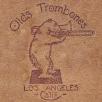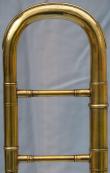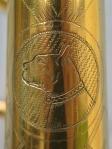
It's a bear!
Medium Bore "The Wallace Trombone" by Williams and Wallace
Bore: .522" (13.3 mm)
Bell: 7½" (190.5 mm)
Play trombone long enough and you'll hear about Earl Williams. His .500" bore Williams Model 6 is legendary thanks to its popularity among studio players during the post-WWII era. Its influence remains strong, both as an inspiration for new designs and in the repeated attempts to restart production of the 6 itself, and the appearance of any original Williams trombone for sale will generally trigger a feeding frenzy among collectors. Biographical information on Earl is available elsewhere, including an excellent article by Robb Stewart and a Facebook page maintained by John Noxon., so I won't go into that here.
But before Williams trombones, there was Williams and Wallace. John Kipper "Spike" Wallace isn't as well known as Earl, but he was a significant figure in Los Angeles music history. Spike first came to Los Angeles in 1906 to play with an orchestra in Avalon on Catalina Island. He eventually became the principal trombone of the Los Angeles Symphony. A multi-instrumentalist, Spike was the string bassist with Paul Whiteman's orchestra during its historic 1919-1920 run at the Alexandria Hotel. When the formation of William Andrews Clark, Jr's new Los Angeles Philharmonic in 1919 brought about the demise of the LA Symphony, Spike became the bass trombonist in the new orchestra - a position he held for almost twenty years, "retiring" in 1938. In 1939, Spike was elected president of the American Federation of Musicians Local 47, serving in that post until his passing in 1950.
Robb Stewart's article on Williams history gives 1928-1936 as the time period for "Williams and Wallace". I've theorized elsewhere as to when the two first met. The firm is not mentioned in the 1927 LA City Directory. It does appear in the directories for 1929 and 1932, but is not present from 1936 forward (note that Earl is listed alone in the 1936 directory). If I were to make a guess at the when and why of the dissolution of the partnership, I would think it might have been related to the major changes going on with the LA Phil in the mid-1930's. The 1934 passing of founder William Andrews Clark, Jr. left a huge void in the finances of the orchestra (he had been, to all intents and purposes, its sole patron since it founding). At one point, it appeared that the orchestra would fold; several musicians, including Spike, are mentioned in an August 21, 1934 Los Angeles Times article as needing to immediately decide whether or not to move on. As we know now, the Phil survived and Spike continued as a member, but perhaps the new management placed increased demands and/or restrictions on their musicians that precluded Spike's contining his business association with Earl. There's also some mystery about what, exactly, each party brought to the partnership. Obviously Earl brought a wealth of manufacturing skill, and Spike brought a degree of local name recognition, but one has to wonder how much input each of them had in the actual design of the instruments - and in the capitalization of the venture.
There doesn't seem to be a single design for a "Wallace Trombone". I've seen some that were tuning-in-slide instruments very similar to this Williams. Others are bell-tuning instruments like the one shown here. There are single bore Wallaces, dual bore Wallaces, small-bore Wallaces and large-bore (at least large for the time) Wallaces. There's at least one Wallace bass trombone, made by Earl for Spike's personal use, and there is at least one Williams and Wallace trumpet.
Now to the trombone itself. It has Earl's trademark curved handbrace (stamped with the patent number, dating the horn to 1930 at the earliest) and ball-end water key lever.It's gold plated, with some very interesting engraving (though not as ornate as some Wallace trombones I've seen). The serial number is in the high 400's; if the generally accepted production estimate (500 units) for the Williams & Wallace parternship, that would place it near the end of the production run, dating it to sometime around 1935.
 Overall View |
 Bell Braces and Tning Slide |
 Engraving Detail |
 Engraving |
 Overall View Reverse |
 Slide Brace and Cork Barrels |
 End Bow |